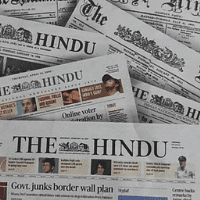Current Affairs Exam > Current Affairs Questions > 'Natya - Shastra' the main source of India's ...
Start Learning for Free
'Natya - Shastra' the main source of India's classical dances was written by
- a)Nara Muni
- b)Bharat Muni
- c)Abhinav Gupt
- d)Tandu Muni
Correct answer is option 'B'. Can you explain this answer?
| FREE This question is part of | Download PDF Attempt this Test |
Verified Answer
'Natya - Shastra' the main source of India's classical dances was writ...
The ‘Natya Shastra' is the oldest surviving ancient indian work on performing arts. The author of ‘Natya Shastra' is unknown, and the Hindu tradition attributes it to the Rishi Bharata ( Bharata Muni ). It may be the work of several authors. Some names are found —Nara Muni, Abhinav Gupta, Tandu Muni.
View all questions of this test
Most Upvoted Answer
'Natya - Shastra' the main source of India's classical dances was writ...
Natya-Shastra: The Main Source of India's Classical Dances
Introduction:
Natya-Shastra is considered to be the main source of India's classical dances. It is an ancient treatise on the performing arts, particularly the art of dance, drama, and music. The Natya-Shastra was written by Bharata Muni, a sage and scholar, who is believed to have lived between the 2nd century BCE and the 2nd century CE. This text is considered to be the foundation for the development of various classical dance forms in India.
Authorship of Natya-Shastra:
The author of Natya-Shastra, Bharata Muni, is believed to have been a sage who lived during the ancient times. While not much is known about him, his work has had a profound influence on the performing arts in India. Bharata Muni is considered to be the father of Indian classical dance and drama.
Content of Natya-Shastra:
Natya-Shastra is divided into 36 chapters and contains detailed descriptions of various aspects of dance, drama, and music. Some of the key topics covered in the text include:
1. Nātya (Drama): The text provides guidance on the different elements of drama, including plot construction, character development, and stagecraft. It also discusses the different types of plays and their classification.
2. Rasa (Sentiment): The concept of rasa is a central theme in Indian aesthetics. Natya-Shastra delves into the different rasas (emotions) and their portrayal in the performing arts.
3. Tāṇḍava and Lāsya: The two main types of dance, Tāṇḍava (masculine, vigorous) and Lāsya (feminine, graceful), are described and differentiated in the text. It provides guidelines for the movements, gestures, and expressions in each type of dance.
4. Bhāva and Abhinaya: The Natya-Shastra explains the concept of bhāva (emotions) and abhinaya (expression) in detail. It outlines the different types of abhinaya, such as āṅgika (body movements), vācika (verbal expression), āhārya (costume and makeup), and sāttvika (emotional states).
5. Musical Elements: The text also covers various aspects of music, including the classification of musical modes (rāgas), musical instruments, and the relationship between music and dance.
Significance of Natya-Shastra:
Natya-Shastra is of immense significance as it provides a comprehensive guide to the art of dance, drama, and music. It lays down the principles and techniques that form the basis of India's classical dance forms, such as Bharatanatyam, Kathak, Odissi, and Kathakali. The text continues to be studied and referenced by dancers, musicians, scholars, and enthusiasts to this day.
Conclusion:
Bharata Muni's Natya-Shastra is a seminal text that has played a pivotal role in shaping the classical dance traditions of India. Its detailed descriptions of various aspects of dance, drama, and music continue to be a valuable resource
Introduction:
Natya-Shastra is considered to be the main source of India's classical dances. It is an ancient treatise on the performing arts, particularly the art of dance, drama, and music. The Natya-Shastra was written by Bharata Muni, a sage and scholar, who is believed to have lived between the 2nd century BCE and the 2nd century CE. This text is considered to be the foundation for the development of various classical dance forms in India.
Authorship of Natya-Shastra:
The author of Natya-Shastra, Bharata Muni, is believed to have been a sage who lived during the ancient times. While not much is known about him, his work has had a profound influence on the performing arts in India. Bharata Muni is considered to be the father of Indian classical dance and drama.
Content of Natya-Shastra:
Natya-Shastra is divided into 36 chapters and contains detailed descriptions of various aspects of dance, drama, and music. Some of the key topics covered in the text include:
1. Nātya (Drama): The text provides guidance on the different elements of drama, including plot construction, character development, and stagecraft. It also discusses the different types of plays and their classification.
2. Rasa (Sentiment): The concept of rasa is a central theme in Indian aesthetics. Natya-Shastra delves into the different rasas (emotions) and their portrayal in the performing arts.
3. Tāṇḍava and Lāsya: The two main types of dance, Tāṇḍava (masculine, vigorous) and Lāsya (feminine, graceful), are described and differentiated in the text. It provides guidelines for the movements, gestures, and expressions in each type of dance.
4. Bhāva and Abhinaya: The Natya-Shastra explains the concept of bhāva (emotions) and abhinaya (expression) in detail. It outlines the different types of abhinaya, such as āṅgika (body movements), vācika (verbal expression), āhārya (costume and makeup), and sāttvika (emotional states).
5. Musical Elements: The text also covers various aspects of music, including the classification of musical modes (rāgas), musical instruments, and the relationship between music and dance.
Significance of Natya-Shastra:
Natya-Shastra is of immense significance as it provides a comprehensive guide to the art of dance, drama, and music. It lays down the principles and techniques that form the basis of India's classical dance forms, such as Bharatanatyam, Kathak, Odissi, and Kathakali. The text continues to be studied and referenced by dancers, musicians, scholars, and enthusiasts to this day.
Conclusion:
Bharata Muni's Natya-Shastra is a seminal text that has played a pivotal role in shaping the classical dance traditions of India. Its detailed descriptions of various aspects of dance, drama, and music continue to be a valuable resource
Free Test
FREE
| Start Free Test |
Community Answer
'Natya - Shastra' the main source of India's classical dances was writ...
The main source of India's classical dances was written by Bharat Muni
The correct answer is option 'B': Bharat Muni.
The main source of India's classical dances is a treatise called 'Natya Shastra'. It is an ancient Indian text that is considered to be the most authoritative work on performing arts in India. The 'Natya Shastra' was written by Bharat Muni, a sage and scholar, around the 2nd century BCE.
Content of the 'Natya Shastra'
The 'Natya Shastra' is a comprehensive text that covers various aspects of performing arts, including dance, music, and drama. It is divided into 36 chapters and contains detailed instructions on different aspects of dance, such as postures, hand gestures (mudras), facial expressions (abhinaya), footwork, and rhythm. It also discusses the different types of classical dances and their regional variations.
Importance of the 'Natya Shastra'
The 'Natya Shastra' is considered to be the foundation of Indian classical dance forms. It provides guidelines and principles that are still followed by dancers and choreographers today. The treatise not only establishes the technical aspects of dance but also explores the aesthetic and spiritual dimensions of the art form.
Legacy of Bharat Muni
Bharat Muni's 'Natya Shastra' has had a profound influence on the development and evolution of classical Indian dance forms. It has served as a guide for generations of dancers and has been instrumental in preserving and promoting the rich cultural heritage of India. Even after centuries, the principles and techniques described in the 'Natya Shastra' continue to be relevant and form the basis of classical dance training.
In conclusion, the main source of India's classical dances, the 'Natya Shastra', was written by Bharat Muni. This ancient text provides comprehensive guidelines for various aspects of dance and continues to be a significant influence on classical dance forms in India.
Attention Current Affairs Students!
To make sure you are not studying endlessly, EduRev has designed Current Affairs study material, with Structured Courses, Videos, & Test Series. Plus get personalized analysis, doubt solving and improvement plans to achieve a great score in Current Affairs.

|
Explore Courses for Current Affairs exam
|

|
Similar Current Affairs Doubts
'Natya - Shastra' the main source of India's classical dances was written bya)Nara Munib)Bharat Munic)Abhinav Guptd)Tandu MuniCorrect answer is option 'B'. Can you explain this answer?
Question Description
'Natya - Shastra' the main source of India's classical dances was written bya)Nara Munib)Bharat Munic)Abhinav Guptd)Tandu MuniCorrect answer is option 'B'. Can you explain this answer? for Current Affairs 2024 is part of Current Affairs preparation. The Question and answers have been prepared according to the Current Affairs exam syllabus. Information about 'Natya - Shastra' the main source of India's classical dances was written bya)Nara Munib)Bharat Munic)Abhinav Guptd)Tandu MuniCorrect answer is option 'B'. Can you explain this answer? covers all topics & solutions for Current Affairs 2024 Exam. Find important definitions, questions, meanings, examples, exercises and tests below for 'Natya - Shastra' the main source of India's classical dances was written bya)Nara Munib)Bharat Munic)Abhinav Guptd)Tandu MuniCorrect answer is option 'B'. Can you explain this answer?.
'Natya - Shastra' the main source of India's classical dances was written bya)Nara Munib)Bharat Munic)Abhinav Guptd)Tandu MuniCorrect answer is option 'B'. Can you explain this answer? for Current Affairs 2024 is part of Current Affairs preparation. The Question and answers have been prepared according to the Current Affairs exam syllabus. Information about 'Natya - Shastra' the main source of India's classical dances was written bya)Nara Munib)Bharat Munic)Abhinav Guptd)Tandu MuniCorrect answer is option 'B'. Can you explain this answer? covers all topics & solutions for Current Affairs 2024 Exam. Find important definitions, questions, meanings, examples, exercises and tests below for 'Natya - Shastra' the main source of India's classical dances was written bya)Nara Munib)Bharat Munic)Abhinav Guptd)Tandu MuniCorrect answer is option 'B'. Can you explain this answer?.
Solutions for 'Natya - Shastra' the main source of India's classical dances was written bya)Nara Munib)Bharat Munic)Abhinav Guptd)Tandu MuniCorrect answer is option 'B'. Can you explain this answer? in English & in Hindi are available as part of our courses for Current Affairs.
Download more important topics, notes, lectures and mock test series for Current Affairs Exam by signing up for free.
Here you can find the meaning of 'Natya - Shastra' the main source of India's classical dances was written bya)Nara Munib)Bharat Munic)Abhinav Guptd)Tandu MuniCorrect answer is option 'B'. Can you explain this answer? defined & explained in the simplest way possible. Besides giving the explanation of
'Natya - Shastra' the main source of India's classical dances was written bya)Nara Munib)Bharat Munic)Abhinav Guptd)Tandu MuniCorrect answer is option 'B'. Can you explain this answer?, a detailed solution for 'Natya - Shastra' the main source of India's classical dances was written bya)Nara Munib)Bharat Munic)Abhinav Guptd)Tandu MuniCorrect answer is option 'B'. Can you explain this answer? has been provided alongside types of 'Natya - Shastra' the main source of India's classical dances was written bya)Nara Munib)Bharat Munic)Abhinav Guptd)Tandu MuniCorrect answer is option 'B'. Can you explain this answer? theory, EduRev gives you an
ample number of questions to practice 'Natya - Shastra' the main source of India's classical dances was written bya)Nara Munib)Bharat Munic)Abhinav Guptd)Tandu MuniCorrect answer is option 'B'. Can you explain this answer? tests, examples and also practice Current Affairs tests.

|
Explore Courses for Current Affairs exam
|

|
Signup for Free!
Signup to see your scores go up within 7 days! Learn & Practice with 1000+ FREE Notes, Videos & Tests.
























